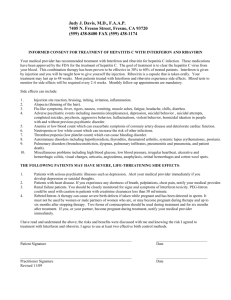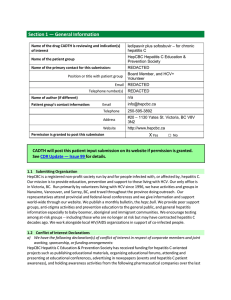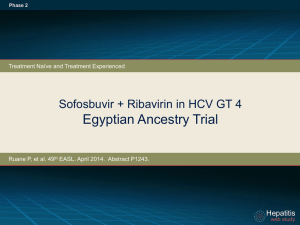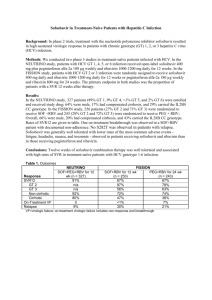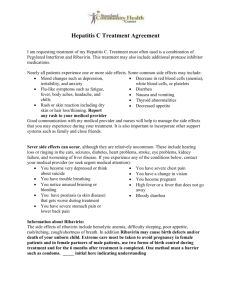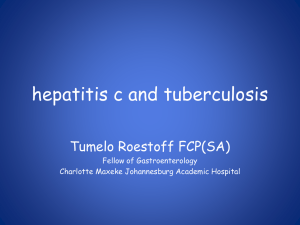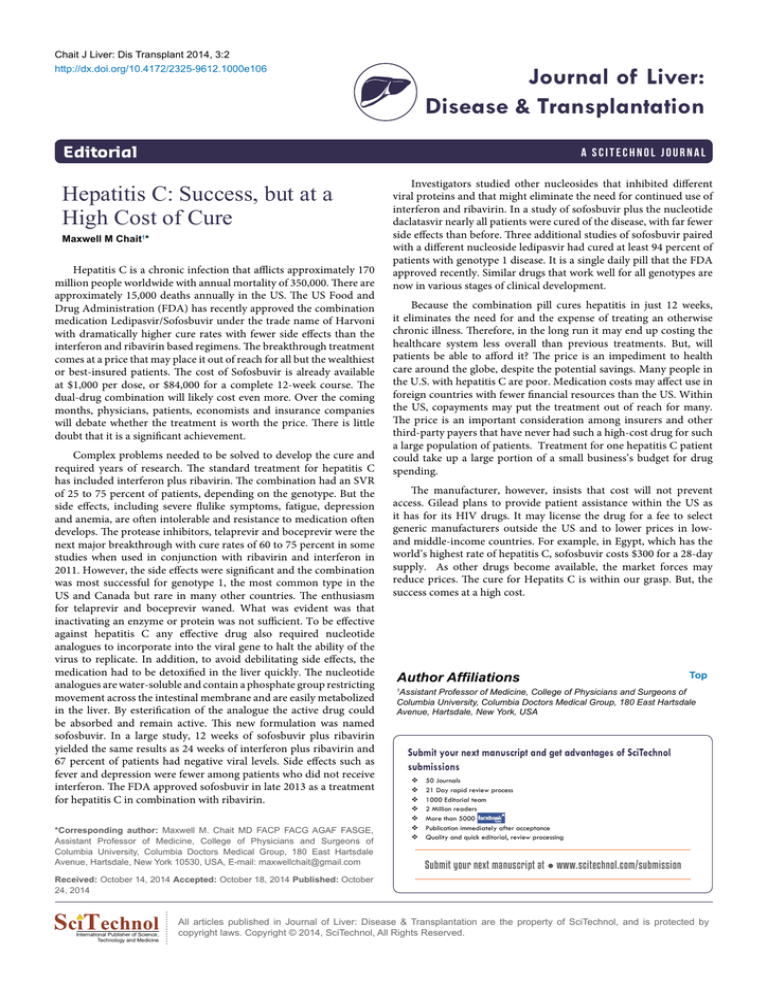
Chait J Liver: Dis Transplant 2014, 3:2
http://dx.doi.org/10.4172/2325-9612.1000e106
Journal of Liver:
Disease & Transplantation
Editorial
a SciTechnol journal
Hepatitis C: Success, but at a
High Cost of Cure
Maxwell M Chait1*
Hepatitis C is a chronic infection that afflicts approximately 170
million people worldwide with annual mortality of 350,000. There are
approximately 15,000 deaths annually in the US. The US Food and
Drug Administration (FDA) has recently approved the combination
medication Ledipasvir/Sofosbuvir under the trade name of Harvoni
with dramatically higher cure rates with fewer side effects than the
interferon and ribavirin based regimens. The breakthrough treatment
comes at a price that may place it out of reach for all but the wealthiest
or best-insured patients. The cost of Sofosbuvir is already available
at $1,000 per dose, or $84,000 for a complete 12-week course. The
dual-drug combination will likely cost even more. Over the coming
months, physicians, patients, economists and insurance companies
will debate whether the treatment is worth the price. There is little
doubt that it is a significant achievement.
Complex problems needed to be solved to develop the cure and
required years of research. The standard treatment for hepatitis C
has included interferon plus ribavirin. The combination had an SVR
of 25 to 75 percent of patients, depending on the genotype. But the
side effects, including severe flulike symptoms, fatigue, depression
and anemia, are often intolerable and resistance to medication often
develops. The protease inhibitors, telaprevir and boceprevir were the
next major breakthrough with cure rates of 60 to 75 percent in some
studies when used in conjunction with ribavirin and interferon in
2011. However, the side effects were significant and the combination
was most successful for genotype 1, the most common type in the
US and Canada but rare in many other countries. The enthusiasm
for telaprevir and boceprevir waned. What was evident was that
inactivating an enzyme or protein was not sufficient. To be effective
against hepatitis C any effective drug also required nucleotide
analogues to incorporate into the viral gene to halt the ability of the
virus to replicate. In addition, to avoid debilitating side effects, the
medication had to be detoxified in the liver quickly. The nucleotide
analogues are water-soluble and contain a phosphate group restricting
movement across the intestinal membrane and are easily metabolized
in the liver. By esterification of the analogue the active drug could
be absorbed and remain active. This new formulation was named
sofosbuvir. In a large study, 12 weeks of sofosbuvir plus ribavirin
yielded the same results as 24 weeks of interferon plus ribavirin and
67 percent of patients had negative viral levels. Side effects such as
fever and depression were fewer among patients who did not receive
interferon. The FDA approved sofosbuvir in late 2013 as a treatment
for hepatitis C in combination with ribavirin.
*Corresponding author: Maxwell M. Chait MD FACP FACG AGAF FASGE,
Assistant Professor of Medicine, College of Physicians and Surgeons of
Columbia University, Columbia Doctors Medical Group, 180 East Hartsdale
Avenue, Hartsdale, New York 10530, USA, E-mail: maxwellchait@gmail.com
Investigators studied other nucleosides that inhibited different
viral proteins and that might eliminate the need for continued use of
interferon and ribavirin. In a study of sofosbuvir plus the nucleotide
daclatasvir nearly all patients were cured of the disease, with far fewer
side effects than before. Three additional studies of sofosbuvir paired
with a different nucleoside ledipasvir had cured at least 94 percent of
patients with genotype 1 disease. It is a single daily pill that the FDA
approved recently. Similar drugs that work well for all genotypes are
now in various stages of clinical development.
Because the combination pill cures hepatitis in just 12 weeks,
it eliminates the need for and the expense of treating an otherwise
chronic illness. Therefore, in the long run it may end up costing the
healthcare system less overall than previous treatments. But, will
patients be able to afford it? The price is an impediment to health
care around the globe, despite the potential savings. Many people in
the U.S. with hepatitis C are poor. Medication costs may affect use in
foreign countries with fewer financial resources than the US. Within
the US, copayments may put the treatment out of reach for many.
The price is an important consideration among insurers and other
third-party payers that have never had such a high-cost drug for such
a large population of patients. Treatment for one hepatitis C patient
could take up a large portion of a small business’s budget for drug
spending.
The manufacturer, however, insists that cost will not prevent
access. Gilead plans to provide patient assistance within the US as
it has for its HIV drugs. It may license the drug for a fee to select
generic manufacturers outside the US and to lower prices in lowand middle-income countries. For example, in Egypt, which has the
world’s highest rate of hepatitis C, sofosbuvir costs $300 for a 28-day
supply. As other drugs become available, the market forces may
reduce prices. The cure for Hepatits C is within our grasp. But, the
success comes at a high cost.
Author Affiliations
Top
Assistant Professor of Medicine, College of Physicians and Surgeons of
Columbia University, Columbia Doctors Medical Group, 180 East Hartsdale
Avenue, Hartsdale, New York, USA
1
Submit your next manuscript and get advantages of SciTechnol
submissions
50 Journals
21 Day rapid review process
1000 Editorial team
2 Million readers
More than 5000
Publication immediately after acceptance
Quality and quick editorial, review processing
Submit your next manuscript at ● www.scitechnol.com/submission
Received: October 14, 2014 Accepted: October 18, 2014 Published: October
24, 2014
International Publisher of Science,
Technology and Medicine
All articles published in Journal of Liver: Disease & Transplantation are the property of SciTechnol, and is protected by
copyright laws. Copyright © 2014, SciTechnol, All Rights Reserved.

